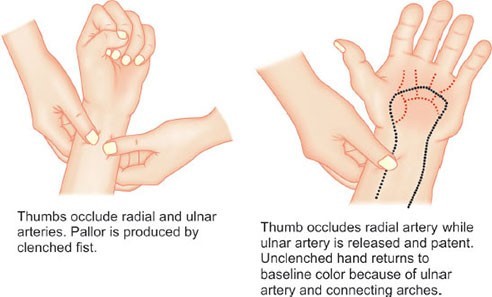When should the nurse conduct an Allen's test?
Just before arterial blood gasses are drawn peripherally.
Prior to attempting a cardiac output calculation.
To assess for presence of a deep vein thrombus in the leg.
When pulmonary artery pressures are obtained.
The Correct Answer is A
Allen's test is a procedure used to assess the patency of the ulnar artery and the collateral circulation of the hand. It is performed to determine the adequacy of collateral circulation before obtaining arterial blood gases from the radial artery. The test helps ensure that the ulnar artery is functioning properly and can supply blood to the hand if the radial artery is used for blood sampling or other invasive procedures.
The test involves occluding both the ulnar and radial arteries while the patient clenches their fist. The nurse then releases pressure on the ulnar artery while maintaining occlusion of the radial artery. The hand should quickly regain normal coloration, indicating adequate collateral circulation.
It's important to note that the Allen's test is specific to the assessment of collateral circulation in the hand and is not used for other purposes such as assessing deep vein thrombosis, cardiac output calculation, or obtaining pulmonary artery pressures.

Nursing Test Bank
Naxlex Comprehensive Predictor Exams
Related Questions
Correct Answer is D
Explanation
The correct answer is Choice D
Choice A rationale: Splinting with a pillow may reduce discomfort during movement or coughing by stabilizing the incision site, but it does not address acute postoperative pain with sympathetic overdrive. The elevated heart rate, respiratory rate, and blood pressure suggest a stress response mediated by catecholamines. Without analgesia, nociceptive signals continue to activate the hypothalamic-pituitary-adrenal axis. While splinting is supportive, it lacks the pharmacologic efficacy needed to blunt nociceptive transmission at the spinal or supraspinal level.
Choice B rationale: Assessing IV patency is a procedural prerequisite for medication administration but not a therapeutic intervention in itself. It does not directly address the pathophysiology of acute pain or the sympathetic surge evidenced by tachycardia and hypertension. Pain activates ascending pathways via A-delta and C fibers, requiring pharmacologic blockade. IV access assessment is necessary but secondary to the urgent need for analgesia to prevent complications like hypoxia, hyperventilation, or delayed recovery.
Choice C rationale: High Fowler positioning may improve diaphragmatic excursion and reduce pulmonary complications, but it does not mitigate visceral or incisional pain. In fact, increased intra-abdominal pressure from upright posture may exacerbate pain at the surgical site. Pain perception involves central sensitization and peripheral nociceptor activation, which are unaffected by positioning. The client’s pale skin and elevated vitals indicate systemic distress requiring analgesic intervention, not postural adjustment. Thus, this choice lacks direct analgesic benefit.
Choice D rationale: IV analgesics act rapidly to inhibit nociceptive transmission at the spinal cord and brainstem levels. Opioids bind to mu receptors, reducing neurotransmitter release and hyperpolarizing neurons, thereby dampening pain signals. This intervention directly targets the physiologic cause of elevated heart rate, respiratory rate, and blood pressure. Normal heart rate is 60–100 bpm, respiratory rate 12–20 breaths/min, and BP <120/80 mmHg. Prompt analgesia prevents complications like hypoxia, delayed healing, and neuroendocrine stress
Correct Answer is C
Explanation
Delusions and loss of control can be distressing for the client and potentially disruptive to the unit environment. Moving the client to a quiet place helps create a calm and less stimulating environment, which can help reduce agitation and promote a sense of safety and security.
Using firmness and directing the client to sit for a while may escalate the situation and increase the client's distress. It is important to approach the client with empathy and provide a supportive environment rather than exerting control through firmness.
Suggesting the client take a walk or encouraging the client to use a punching bag may not be appropriate if the client is already displaying signs of agitation and losing control. These interventions may not address the underlying causes of the delusions and could potentially worsen the situation.
Whether you are a student looking to ace your exams or a practicing nurse seeking to enhance your expertise , our nursing education contents will empower you with the confidence and competence to make a difference in the lives of patients and become a respected leader in the healthcare field.
Visit Naxlex, invest in your future and unlock endless possibilities with our unparalleled nursing education contents today
Report Wrong Answer on the Current Question
Do you disagree with the answer? If yes, what is your expected answer? Explain.
Kindly be descriptive with the issue you are facing.
